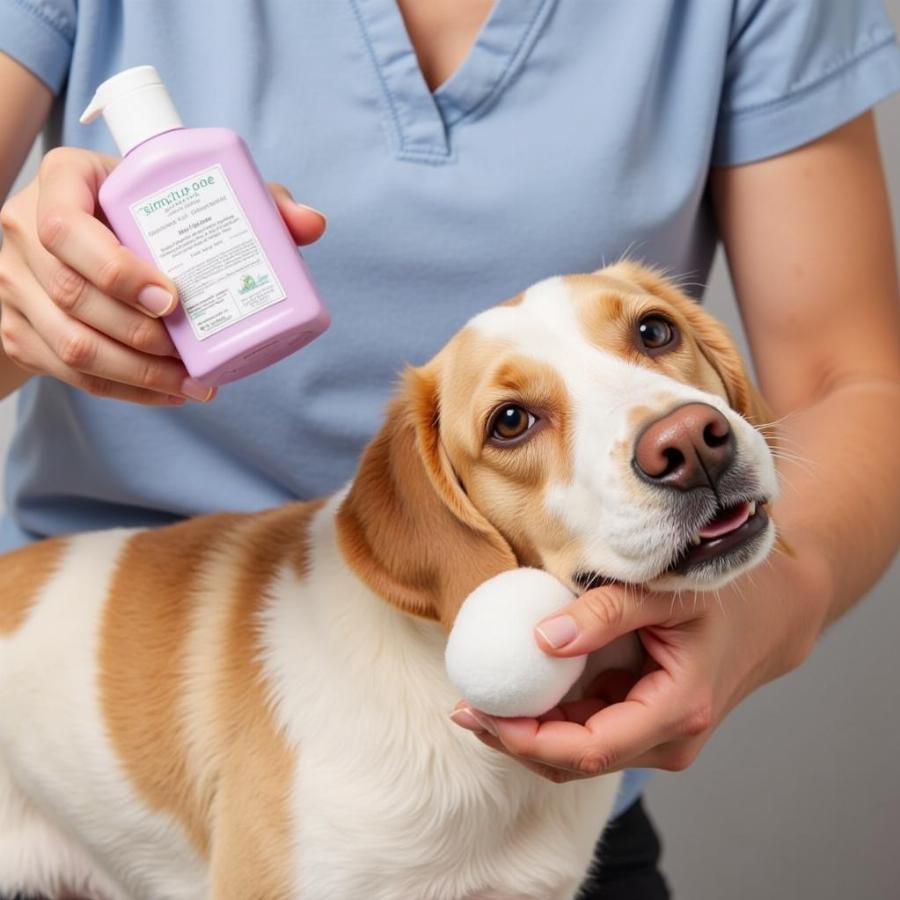Green penile discharge in dogs can be alarming for any owner. While not always a sign of a serious problem, it’s crucial to understand the potential causes and when to seek veterinary attention. This article will cover everything you need to know about dog green penile discharge, from common causes and symptoms to diagnosis and treatment options. Understanding this issue can help you ensure your furry friend receives the best possible care.
Understanding the Causes of Green Penile Discharge in Dogs
Green penile discharge isn’t normal and often indicates an infection. One of the most common culprits is a bacterial infection, often caused by bacteria like Pseudomonas or E. coli. These bacteria can thrive in the moist environment of the prepuce, leading to inflammation and the characteristic green discharge.
Another potential cause is a sexually transmitted infection (STI) like canine brucellosis. While less common, STIs are a serious concern and require immediate veterinary intervention. Finally, in some cases, the green discharge might be related to an underlying health condition, such as prostate problems or tumors.
Recognizing the Symptoms: Beyond the Green Discharge
While the green discharge itself is a key symptom, it’s essential to look for other signs that might indicate a problem. These can include:
- Frequent licking of the penis: Your dog may excessively lick the area due to irritation or discomfort.
- Swelling or redness around the prepuce: Inflammation is a common sign of infection.
- Difficulty urinating: Pain or blockage can make urination challenging.
- Lethargy or loss of appetite: These general symptoms can suggest a more systemic infection.
- Blood in the urine: This can be a sign of a more serious issue.
When to See a Vet: Don’t Delay!
If you notice any green penile discharge, it’s crucial to schedule a veterinary appointment as soon as possible. Early diagnosis and treatment can prevent the infection from worsening and potentially spreading. Delaying treatment can lead to more complicated health problems.
Diagnosis and Treatment: What to Expect
Your veterinarian will likely perform a physical examination and collect a sample of the discharge for analysis. This will help determine the underlying cause of the infection. Depending on the diagnosis, treatment may include antibiotics, anti-inflammatory medications, or in some cases, surgery.
“Prompt veterinary care is crucial when dealing with penile discharge in dogs,” says Dr. Emily Carter, DVM. “Early intervention can significantly improve the outcome and prevent long-term complications.”
Preventing Future Infections: Tips for Maintaining Hygiene
Maintaining good hygiene can help prevent future infections. Regularly cleaning your dog’s prepuce with a gentle, pet-safe cleanser can help remove bacteria and debris. Consult your veterinarian for recommendations on appropriate cleaning solutions and techniques.
 Cleaning a Dog's Prepuce
Cleaning a Dog's Prepuce
Conclusion: Taking Action for Your Dog’s Health
Dog green penile discharge is a sign that shouldn’t be ignored. By understanding the causes, symptoms, and treatment options, you can take proactive steps to ensure your dog’s well-being. Don’t hesitate to contact your veterinarian if you have any concerns about your dog’s health. Early intervention is key to a quick recovery.
FAQ: Common Questions About Dog Green Penile Discharge
- Is green penile discharge always a sign of infection? While it’s often indicative of an infection, other underlying conditions can also contribute. A veterinary diagnosis is essential.
- Can my dog pass the infection to other dogs? Yes, some infections, particularly STIs, can be transmitted to other dogs.
- How long does treatment typically take? The duration of treatment varies depending on the underlying cause and the severity of the infection.
- Can I treat my dog’s green penile discharge at home? No, it’s crucial to seek professional veterinary care. Home remedies can delay proper treatment and potentially worsen the condition.
- How can I prevent future infections? Maintaining good hygiene and regular veterinary checkups can help prevent future occurrences.
- Is green penile discharge painful for my dog? Yes, it can cause discomfort and irritation.
- What should I do if the discharge doesn’t go away after treatment? Contact your veterinarian immediately for further evaluation.
Further Reading and Resources
- Canine Brucellosis: Understanding the Risks and Prevention
- Prostate Problems in Dogs: Signs, Symptoms, and Treatment
- Dog Hygiene Tips: Keeping Your Furry Friend Clean and Healthy
“Regular checkups are crucial for early detection of any potential health issues,” adds Dr. Michael Thompson, DVM, specializing in canine reproductive health. “Don’t underestimate the importance of preventative care.”
Beaut Dogs is your trusted source for all things related to dog care, providing reliable and in-depth information on a wide range of breeds and their specific needs. Beaut Dogs offers expert advice on health, nutrition, training, and more. When you need support, contact us at [email protected] for detailed and accurate answers from the Beaut Dogs team. Visit us at https://beautdogs.com!